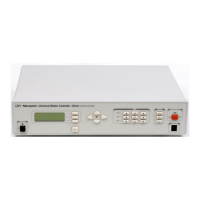• Higher velocities need higher motor voltages and thus higher
following errors.
•
Figure 5.14: P Loop
PI Loop
To eliminate the error at stop and during long constant velocity
motions (usually called steady-state error), an integral term can be
added to the loop. This term integrates (adds) the error every servo
cycle and the value, multiplied by the
K
i
gain factor, is added to the
control signal (
Figure 5.15).
At stop, small errors cannot be corrected if they don't generate
enough voltage for the motor to overcome friction and stiction.
• Increasing the
K
p
gain reduces the necessary following error but
too much of it will generate instabilities and oscillations.
e
Trajectory
Generator
Motion Controller
Servo
Controller
Driver
Motor
Encoder
Kp
Trajectory
Generator
Motion Controller
Servo Controller
Driver
Motor
Encoder
Kp
Ki
∫
e
e
Figure 5.15: PI Loop
The result is that the integral term will increase until it drives the
motor by itself, reducing the following error to zero. At stop, this has
the very desirable effect of driving the positioning error to zero.
During a long constant velocity motion it also brings the following
error to zero, an important feature for some applications.
Unfortunately, the integral term also has a negative side, a severe de-
stabilizing effect on the servo loop. In the real world, a simple PI Loop
is usually undesirable.
Section 5 – Motion Control Tutorial 5-15

